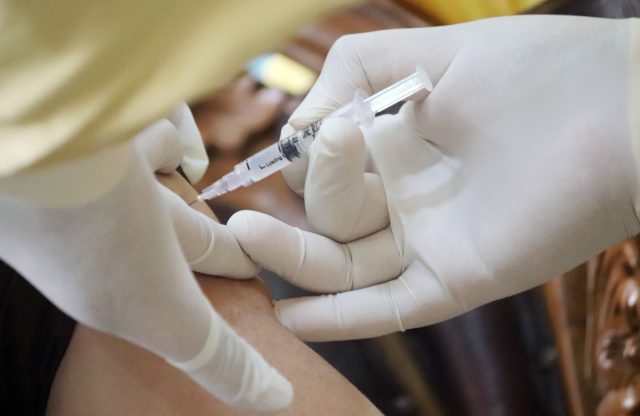Dr Robert Hess: Managing the Covid-19 aftermath

Dr Robert Hess – 03/07/2022
Dr Robert Hess: Managing the Covid-19 aftermath: Detox of the spike-protein.
Two full years after the pandemic began, it is now time to consider our next moves. In order to maintain a clear overview, I placed great emphasis on accurate documentation and ongoing information exchange right from the start. This meticulous approach, together with insights from science and research findings, enabled us to make precisely tailored recommendations for our clients. In the last few weeks and months, we have been gathering up loose ends and shifting our focus to appropriate preventive measures as well as preparations for the aftermath of the Covid-19 pandemic. In addition to shortening test intervals and adapting diagnostic methods, we will now also review the composition of our supplements to ensure that they are likewise optimally adjusted to the individual pandemic-related circumstances of our clients.
The focus of our prophylactic supplement program and of the measures we are taking for the COVID-19 aftermath is primarily on the spike protein. The spike protein, which is not only a component of the SARS-CoV-2 virus but also produced in our bodies as a result of vaccination, can circulate in our bodies and damage cells, tissues and organs. It is our view that “detoxing” the body of spike proteins as soon as possible after infection or vaccination can protect against damage from residual or circulating spike proteins. Various international committees have been drawing up guidelines and collating information on how to remove viral and vaccine-induced spike proteins from the body. The lists of herbal medicines and dietary supplements together with the information on them were compiled in collaboration with international physicians, scientists and health practitioners.
COVID-19 infection, COVID-19 vaccines and spike protein damage are all relatively new phenomena, so the guidelines have been based on established and recent medical research as well as the clinical experience of international physicians. The respective guidelines will be updated on an ongoing basis as new knowledge and findings emerge. We will review the guidelines, herbal medicines and dietary supplements, as well as other measures and, as appropriate, incorporate them into our program and adapt them individually for our clients.
What exactly is the spike protein?
The SARS-CoV-2 virus first identified in Wuhan has spike protein on its surface. The spike protein is also found in all SARS-CoV-2 variants. In a natural infection, the spike protein is the component of the virus that allows it to enter the cells of your body. One region of the protein, called S2, binds the viral envelope to the cell membrane. The S2 region also has the effect of making the SARS-CoV-2 spike protein easily recognizable to the immune system, which then produces antibodies that attack and bind to the virus.
Spike proteins are also produced by the human body following vaccination against COVID-19 and function in a similar way, in that they can fuse with cell membranes. It is not yet entirely clear to what extent spike proteins formed by vaccination interact with our immune system, as they are produced in our own cells, but this does not necessarily mean that an immune response cannot also be triggered. Misdirected immune responses (i.e. the inability of our immune system to distinguish between virus-related and vaccine-produced spike protein) could have devastating consequences and damage healthy cells in our body.
Why should I consider a spike protein detox?
Recent research has linked viral spike protein to negative effects and consequences, such as blood clots, brain fog, pneumonia, and heart muscle inflammation. A Japanese-led biodistribution study examining the Pfizer/BioNTech vaccine also demonstrated that the vaccine particles had reached various tissues throughout the body within 48 hours of vaccination and did not remain at the injection site, with high concentrations found in the liver, bone marrow and ovaries. New evidence also shows that the spike protein may interfere with the ability of our cells to repair DNA. All of the above taken in the context of Long Covid prompted us to focus more on this issue. Taking preventive action in this area could be of tremendous benefit on multiple levels.
If you have had side-effects after being vaccinated or if you suffer from Long Covid or Long Covid-like symptoms, the “Spike Detox” is one of the best ways to tackle your symptoms. Even if you have not experienced any of the above phenomena and have ever been vaccinated or infected with COVID-19 (with or without symptoms), this is relevant to you. Spike protein induced by a natural infection or alternatively a COVID-19 vaccine has high potential to damage our cells, so it is important to take steps to detoxify the body as much as possible.
What is the purpose of the Spike Detox?
General measures such as heat therapies, sauna sessions and hot baths, are good ways to detoxify from spike protein. Intermittent fasting, a dietary measure that stimulates the body’s autophagy ability, can also be helpful in this context. This is essentially a recycling process that takes place in human cells, whereby cells break down and recycle components. By means of autophagy, the body eliminates damaged cell proteins and can destroy harmful viruses and bacteria resulting from an infection.
The right diet is, of course, also essential here, the consumption of pro-inflammatory foods should be avoided, and it also makes sense to aim for a low-histamine diet. The daily intake of important multivitamins and minerals is essential – we already cover this with our personalized supplements.
The targeted spike protein detox primarily refers to four different components, which we will discuss in more detail below:
– the spike protein
– ACE2 receptors
– interleukin 6 (IL-6)
– furin
“Protein-binding inhibitors” impede the binding of the spike protein to human cells, while others neutralize the spike protein, rendering it potentially incapable of causing damage to human cells.
Spike protein inhibitors: prunella vulgaris, pine needles, emodin, neem, dandelion leaf extract, ivermectin
Spike protein neutralizers: N-acetylcysteine (NAC), glutathione, fennel tea, star anise tea, pine needle tea, St. John’s wort, comfrey leaves, vitamin C
Ivermectin has been shown to bind to the spike protein, potentially preventing it from binding to the cell membrane. A number of naturally occurring plants – including pine needles, fennel, star anise, St. John’s wort, and comfrey leaves – contain a substance called shikimic acid that may help neutralize the spike protein. Shikimic acid is also believed to counteract the formation of blood clots. Pine needle tea has a strong antioxidant effect and contains high concentrations of vitamin C, which has a key role to play in neutralizing toxins.
What are ACE2 receptors?
ACE2 receptors are found in the cell wall, in the epithelial and endothelial lining of lungs and blood vessels, and in blood platelets (thrombocytes). Spike protein binds to ACE2 receptors, and it is thought that variable concentrations of spike protein can bind and adhere to our ACE2 receptors, blocking their regular function in various tissues. In addition, the “stickiness” of the spike protein at the ACE2 receptor could cause the immune system to attack healthy cells and possibly trigger autoimmune diseases.
Substances that can naturally protect ACE2 receptors: ivermectin, quercetin (with zinc), fisetin
There is evidence that, when ivermectin binds to an ACE2 receptor, this prevents the spike protein from binding to it.
Why attack IL-6?
Some natural substances support the detoxification process after infection by acting on interleukin- 6. It has been scientifically proven that cytokines such as IL-6 are present at much higher levels in individuals who have been infected with COVID-19 than in those who have not. IL-6 has also been used as a parameter for measuring the progression of COVID-19 cases. In 2021, a meta-analysis using worldwide datasets showed a correlation between IL-6 levels and the severity of COVID-19 disease and demonstrated that IL-6 levels were inversely related to the number of T cells in ICU patients.
IL-6 inhibitors (anti-inflammatories): Boswellia serrata (frankincense) and dandelion leaf extract
Other IL-6 inhibitors: black cumin (Nigella sativa), curcumin, fish oil and other fatty acids, cinnamon, fisetin (flavonoid), apigenin, quercetin (flavonoid), resveratrol, luteolin, vitamin D3 (with vitamin K), zinc, magnesium, jasmine tea, spices, bay leaves, black pepper, nutmeg, and sage
Several natural, plant substances are used in antiviral therapy. The plant pigment quercetin has been shown to have broad-spectrum anti-inflammatory and antiviral effects. Zinc acts as a powerful antioxidant that protects the body from oxidative stress, a process associated with DNA damage, excessive inflammation and other harmful effects.
What is furin?
Furin is an enzyme that cleaves proteins and makes them biologically active.
Furin has been shown to cleave the spike protein, allowing the virus to enter human cells. There is a furin cleavage site on the spike protein of COVID-19, which is thought to make the virus more infectious and transmissible. Furin inhibitors could therefore prevent cleavage and thus activation of the spike protein.
Furin inhibitors: rutin, limonene, baicalein, hesperidin
Many of these measures and detox options are already part of our program. All further suggestions and research results will be reviewed in the coming weeks for our clients and, if we consider them to be necessary, safe and prophylactic, they will be individually incorporated into the supplements. It is therefore of enormous benefit that we are up to date regarding the infection, recovery and vaccination situation of each client. If you have any further questions or if we do not have all the information about your individual situation, please do not hesitate to contact your consultant.



